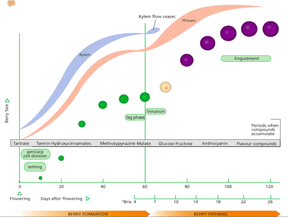Since I knew that I was going to craft a barrel of wine during the fall of 2009, I decided to take an online class on winemaking. There are several online classes on winemaking and viticulture offered by Washington State University Extension. The class, Introduction to Winemaking, consists of seven lessons accompanied by a Powerpoint-type presentation and narrated by Dr. James F. Harbertson, an Extension Enologist.
I began to take the classes in March and quickly decided to put them off until September and October. It didn’t take long to determine that the classes were heavy into the science and having access to a real lab at the wineries will make the classes more enjoyable than some virtual lab in my imagination.
 The first lesson was an overview of winemaking and determining ripeness. It didn’t cover much about winemaking at all other than what a winemaker would like to have in grapes that reach the winery. The majority of this lesson was about the vineyard and the development of grapes. Several slides were devoted to determining ripeness.
The first lesson was an overview of winemaking and determining ripeness. It didn’t cover much about winemaking at all other than what a winemaker would like to have in grapes that reach the winery. The majority of this lesson was about the vineyard and the development of grapes. Several slides were devoted to determining ripeness.
My general impression of the lesson is that it covered the vineyard, grape development and when to harvest in a much broader and deeper context than the class at Vint Hill Craft Winery. Would people crafting a barrel of wine benefit from the first lesson in the winemaking class? I believe so if they are into the science behind what they are doing or about to do. The lesson did however cause concern.
A winemaker who has access to a vineyard can go into the vineyard after veraison and test for sugar and acidity. When the vineyard is thousands of miles away, one is somewhat at the mercy of the grower. True a winemaker who receives less than desirable grapes can choose a different grower the following year, so there is some market control for quality. However if people are going to only craft one barrel of wine, they have to take what they receive. Herein lies a certain degree of worry. What will the grapes be like?
The lesson discussed the ranges for brix (the measure of sugar) and acidity. There are two measures dealing with the acidity, TA that is the concentration of acidity in grams per liter and pH (remember high school chemistry class). When my grapes arrive at Vint Hill Craft Winery in Virginia and Tin Lizzie Wineworks in Maryland, I’ll test to determine the degree of brix, TA and pH. This data will hopefully prove valuable for making decisions.



Leave a Reply